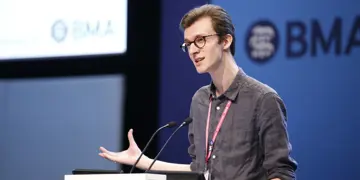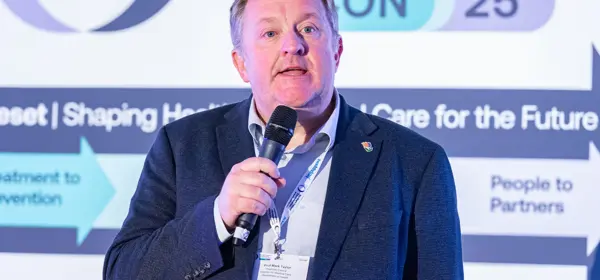Call for ‘stable’ supply of medical professionals
Call for ‘stable’ supply of medical professionals
Government plan to double medical school numbers questioned
Doctors have called for a ‘stable and adequate supply of medical professionals’, aligning the number of medical student places with workforce needs and postgraduate training.
A motion tabled by the BMA’s medical students committee commits the association to rethinking its support for government plans to double medical school places to 15,000 by 2031/32.
The new policy, voted through at the association’s annual representative meeting in Liverpool, calls for the BMA to lobby for maintaining current medical student intake numbers, with no increases unless the quality of medical education and training can be guaranteed, and reviewing these numbers in response to changing healthcare demands.
It comes as an additional 350 places are being introduced for 2025/26, and medical students complain about overcrowded courses and placements and deteriorating educational opportunities.
Rob Tucker, chair of the BMA’s medical students committee, called for engagement with stakeholders ahead of the NHS England’s long-term workforce plan, expected in the autumn, the medical training review being overseen by chief medical officer for England Professor Sir Chris Whitty and devolved nations considering their workforce strategies.
‘We know we will only make the bottlenecks worse if we double medical school places,’ said Mr Tucker. ‘It is now time we link UK medical school numbers to effective workforce planning, for healthcare demands, workforce projections and educational capacity.
‘We must, as an organisation, begin to acknowledge but rethink our support for arbitrary doubling of medical student places while we’re in a clinical academic crisis and with bottlenecks accessing specialty training.’
‘Overcrowding’
ARM representatives heard testimonials from Scottish medical students, who described ‘overcrowded placements without meaningful clinical teaching’, ‘growing uncertainty of accessing the quality of teaching opportunities that previous cohorts have had’ and class sizes ‘so large that each individual doesn’t even get a turn in clinical skill session’, as many as eight students observing one GP appointment and students left watching dissections on their phones outside of rooms.
Toby McDonald, a medical student in Scotland, said: ‘Ward rounds are turning into traffic jams with sometimes up to six medical students arguing over whose turn it is to open and close the bedside curtain.
‘Clinics are busy and disruptive with medical students jumping in and out between patients, getting their crack at a sign off. Purpose-built medical school lecture theatres are abandoned as they no longer fit the entire year’s cohort.
Students’ leaning experiences are hampered by clinical staff stretching their primary resources to the limit.’
With the annual medical student intake in Scotland having grown by 50 per cent from 1,000 in 2017 to 1,500 today, and plans to increase the numbers again, he said: ‘It is all happening in the context of an NHS that is bursting under pressure and universities facing financial collapse, so is it any surprise that students are having these experiences when there are 50 per cent more of us but there are not 50 per cent more clinical teaching staff, anatomy labs, ward space or tutors.
‘It’s putting us in a terrible situation now, where students are relying more on online paid-for-out-of-pocket teaching platforms for their education rather than tutorials and lectures from their university. Does this sound like high-quality medical education?’
Mr McDonald said a ‘desire for cheap political headlines about greater numbers of medical students’ that has led to this, and that short-termism ‘has failed us’: ‘It’s time to be brave and fight for the future of future doctors.’
The training pipeline
John Gillespie, a foundation year 2 doctor in London, said that while he is ‘passionate about lobbying for sustainable workforce planning’ and did not agree with ‘artificially imposed speciality training bottlenecks’ for resident doctors, he felt maintaining current numbers was a ‘short-sighted view’.
‘Patients deserve doctor-led healthcare. To achieve this, we must build sustainable training pipelines – not just to meet today’s clinical demands but also to prepare for the increasing complexity of care over the next decade.’
He said past workforce shortages led to the ‘troubling trend’ of doctors being substituted for non-medical associate professionals, as reflected in other debates at this year’s ARM.
‘These motions speak to the pressing need for more doctors now, let alone in the future. We must avoid a boom-and-bust strategy when it comes to workforce planning.’
He cited the 2008 ARM voting against an expansion of medical school places, ‘a decision which in hindsight contributed to severe staff shortages’.
‘If not for the invaluable contribution of our international medical colleagues to help correct the deficit then our healthcare system may not have coped.’
Dr Gillespie noted OECD data that shows the UK is under-doctored compared to other countries in the EU, ‘highlighting the substantial need to continue to grow our workforce’.
He said: ‘We must fill the gaps in workforce planning by committing to an ambitious workforce plan which expands our existing medical training pipelines. Let us be bold in ensuring that patients tomorrow, like patients today, can count on doctor-led healthcare.’
Future opportunities
Retired doctor Stephen Millar, a former workforce planner, said they had been able to create multiple additional training posts during austerity.
‘Do not be defeatist, it can be done,’ he told delegates.
‘We all want our young doctors to have a quality education and to progress their careers. Restricting medical school intake is not a lever to get post-graduate training expansion, it’s an excuse to not fund it.
‘It will deny future cohorts of school leavers an opportunity to come into our profession, it will allow manager to push the existing workforce even harder to do more and more work, we will recruit more doctors from overseas from countries that can ill-afford to lose them, they will recruit more PAs, we will no longer be able to criticise government for failing to invest in the workforce – instead governments will blame us for the workforce crisis, because we were protectionist and sought to prevent entry into the profession.’
He called the motion a ‘recipe for stagnation’ that would stifle ‘the expansion we need’.
Educational placements
Callum Williams, a medical student in Scotland, and deputy co-chair for education and training on the UK medical students committee, said his university struggled to find enough space in GP surgeries so students ended up with just two days’ placement across a four-week block.
‘Hardly a quality educational experience,’ he said.
Addressing the argument that the motion might make the BMA look protectionist, he said: ‘Perhaps. But maybe that’s what we need to do? We need to send a strong statement to government and say this is not acceptable.
How can we have more medical students going into the system when we don’t have jobs for them?’
‘Trusts do not have the capacity to provide high quality educational placements. Our current students are having a reduced standard of medical education, and then when they’re coming out they’re facing horrific recruitment processes that often make errors and leave them with the risk of unemployment.
‘We need to make a clear statement to government to say “until you sort out these issues with quality, until you have enough jobs for doctors, stop taking the politically expedient option and let’s pause medical school place expansion”.’
BMA council chair Professor Phil Banfield, said the shortage of doctors in the UK was ‘well-documented’ but warned that previous BMA lobbying for medical school expansion could sit uneasily with the new policy, and could give the government an opportunity to ‘cease medical expansion altogether, and cite the BMA as the reason for that.’
Responding to the questions, Mr Tucker said: ‘Is us saying we should not be pushing through as many medical students as possible without proper plans truly at fault for rota gaps and limited speciality training posts? I don’t think so.
‘The BMA should not be tied to doubling medical students, it should be tied to effective and considered planning.’
The motion passed in full, with calls to maintain current intake numbers only gradually passing the threshold to make policy at 53 per cent.
ARM representatives also passed a motion recognising that a flawed foundation programme recruitment system for newly-qualified doctors leads to ‘dissatisfaction, burnout, and reduced retention of doctors in the NHS’.
Tabled by the medical students committee, it calls on the UK Foundation Programme Office, statutory education bodies and the four nations’ health departments to prioritise student welfare, communication with applicants and involve student representatives in any decisions taken about the foundation programme.
The motion also urges bodies to minimise the number of students getting their lowest preferences by modifying the preference informed allocation algorithm, guarantee placement allocation at least 12 weeks before the start of the foundation programme, introduce an anonymous and nationally-run swap system for allocations and improve financial and training incentives for foundation priority programmes in ‘under-doctored’ areas.







